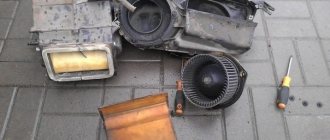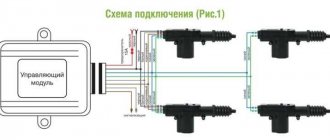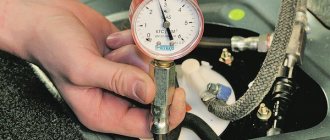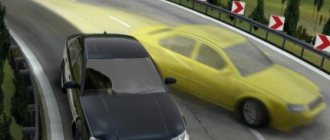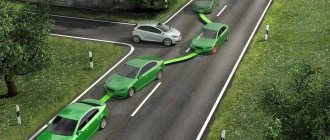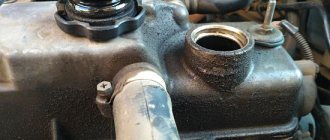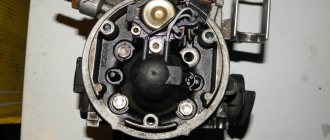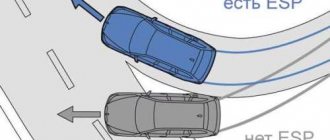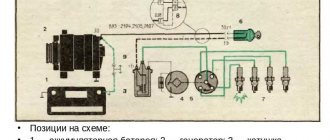Dear readers and subscribers, it’s nice that you continue to study the structure of cars! And now we bring to your attention the electronic fuel injection system, the operating principle of which I will try to explain in this article.
Yes, we’ll talk about those devices that have replaced time-tested carburetor power systems from under the hoods of cars, and we’ll also find out how much modern gasoline and diesel engines have in common.
Electronic fuel injection system
Perhaps we would not have discussed this technology if a couple of decades ago humanity had not become seriously concerned about the environment, and toxic exhaust gases from cars turned out to be one of the most serious problems.
The main drawback of cars with engines equipped with carburetors was incomplete combustion of fuel, and to solve this problem, systems were needed that could regulate the amount of fuel supplied to the cylinders depending on the operating mode of the engine.
Thus, injection systems or, as they are also called, injection systems, appeared in the automotive arena. In addition to improving environmental friendliness, these technologies have improved engine efficiency and power characteristics, becoming a real boon for engineers.
Today, fuel injection is used not only on diesel, but also on gasoline units, which undoubtedly unites them.
They are also united by the fact that the main working element of these systems, no matter what type they are, is the nozzle. But due to differences in the method of fuel combustion, the designs of injection units for these two types of engines, of course, differ. Therefore, we will consider them in turn.
Electronic control unit
This is a microcomputer that processes data coming from sensors and controls actuators according to a certain algorithm.
The program itself is stored in a ROM chip, the English name is CHIP. The contents of the “chip” are usually divided into two functional parts - the program itself, which performs data processing and mathematical calculations, and the calibration block. Calibrations are a set (array) of fixed data (variables) for the operation of the control program.
For proper operation of the injection system, it is necessary to have working sensors and actuators.
Injection systems and gasoline
Electronic fuel injection system. Let's start with gasoline engines. In their case, injection solves the problem of creating an air-fuel mixture, which is then ignited in the cylinder by a spark from the spark plug.
Depending on how this mixture and fuel is supplied to the cylinders, injection systems can have several varieties. Injection happens:
- central;
- distributed;
- direct;
- combined.
Central injection
The main feature of the technology, located first in the list, is one single injector for the entire engine, which is located in the intake manifold. It should be noted that this type of injection system in its characteristics is not very different from a carburetor, therefore today it is considered obsolete.
Distributed injection
Distributed injection is more progressive. In this system, the fuel mixture is also formed in the intake manifold, but, unlike the previous one, each cylinder here boasts its own nozzle.
This variety allows you to experience all the advantages of injection technology, therefore it is most loved by automakers and is actively used in modern engines.
Direct injection
But, as we know, there are no limits to perfection, and in pursuit of even higher efficiency, engineers developed an electronic fuel injection system, namely a direct injection system.
Its main feature is the location of the injectors, which, in this case, extend their nozzles into the combustion chambers of the cylinders.
The formation of the air-fuel mixture, as you might already guess, occurs directly in the cylinders, which has a beneficial effect on the operating parameters of the engines, although this option is not as environmentally friendly as that of distributed injection. Another noticeable drawback of this technology is the high requirements for the quality of gasoline.
Combined injection
The most advanced in terms of the level of emissions of harmful substances is the combined system. This is, in fact, a symbiosis of direct and distributed fuel injection.
Principle of operation
Injection engine units with a single nozzle operate according to the following scheme:
- the engine starts;
- sensors read and transmit information to the control unit;
- real data are compared with reference data, the moment of opening the injector is calculated;
- a signal is transmitted to the electromagnetic coil;
- gasoline is supplied to the manifold for mixing with air;
- The fuel mixture is supplied to the cylinders.
Functioning of a unit with distributed injection:
- air is supplied to the motor;
- sensors determine volume, temperature, crankshaft performance, damper position;
- the volume of fuel for the supplied air is calculated by the control unit;
- a signal is sent to the injectors;
- they open at the programmed time.
- gasoline is mixed with air in the manifold, and the mixture is supplied to the cylinders.
How are diesels doing?
Let's move on to diesel units. Their fuel system is faced with the task of supplying fuel under very high pressure, which, when mixed in the cylinder with compressed air, ignites itself.
There are a lot of options for solving this problem - direct injection into the cylinders is used, and with an intermediate link in the form of a preliminary chamber; in addition, there are various designs of high-pressure pumps (HHP), which also adds variety.
However, modern motorists prefer two types of systems that supply diesel fuel directly to the cylinders:
- with pump injectors;
- Common Rail injection.
Pump nozzle
The pump-injector speaks for itself - in it the nozzle that injects fuel into the cylinder and the injection pump are structurally combined into one unit. The main problem with such devices is increased wear, since the pump injectors are connected by a permanent drive to the camshaft and are never disconnected from it.
Common Rail system
The Common Rail system takes a slightly different approach, making it more preferable. There is one common injection pump, which supplies diesel to the fuel rail, which distributes fuel to the cylinder injectors.
This was just a brief overview of injection systems, so, friends, follow the links in the articles, and using the Engine section, you will find all the injection systems of modern cars to study. And subscribe to the newsletter so as not to miss new publications in which you will find a lot of detailed information on car systems and mechanisms.
See you again!
Tags
engine
Injection duration and flow rate curve (injection)
The term "feed rate" describes the curve of the amount of fuel injected into the combustion chamber as a function of the crankshaft or camshaft angle (crankshaft or camshaft angles, respectively).
One of the main parameters influencing the injection intensity curve is the injection duration. It is measured in crank or cam angles or in milliseconds and is the period during which the injector is open and fuel is injected into the combustion chamber. The figure shows how the amount of fuel injected is started by the pump camshaft and how the fuel is injected from the injector ( as a function of the camshaft angle). It can be seen that the pressure characteristic and injection rate curve vary greatly between the pump element and the injector, and that they are influenced by the parts that determine the injection (cam, pump element, injection valve, fuel line (feed line) and injector).
Different diesel engine systems require different injection times in each case. Engines with direct injection require approximately 25 - 30° of crankshaft rotation at a certain number of revolutions, and engines with pre-chamber require a crankshaft rotation angle of 35 - 40°. The injection duration at a 30° crankshaft rotation corresponding to a 15° camshaft rotation means an injection duration of 1.25 milliseconds for an injection pump speed of 2000 rpm.
To keep fuel consumption and sulfur emissions low, the injection duration must be determined as a function of the operating point and depends on the start of injection. At the start of injection, only a small amount of fuel should flow, while at the end a large amount of fuel is required. The injector should then close as quickly as possible. This feed rate curve will result in a slow increase in compression pressure. The combustion will thus be “soft”. In direct injection engines, combustion noise is noticeably reduced if a small portion of the fuel injected into the combustion chamber is finely atomized before the main injection.
This injection method remains very expensive. Engines with a split combustion chamber (pre-chamber or swirl chamber) use needle throttling injectors. These injectors produce a single jet of fuel and determine the flow rate curve. The injectors control the outlet cross-section as a function of the injection valve (discharge valve) stroke.
Secondary injection (or so-called "dripping") is particularly undesirable and occurs when the injector quickly re-opens after it has closed, and it injects poorly prepared fuel later in the combustion process. This fuel does not burn completely or does not burn at all and exits through the exhaust gases as unburned hydrocarbons.
Quick-closing nozzles prevent this “dripping.” The "dead volume" at the bottom of the injector seat produces an effect similar to "dripping". Fuel vapors accumulated in this volume exit into the combustion chamber after combustion is completed and also enter the exhaust gases, where they increase emissions of unburned hydrocarbons. The smallest “dead volume” is obtained with injectors with a seat with holes.
Advantages
Injectors have many advantages
- Saving.
Due to the dosed supply of fuel, its consumption is reduced. Even in the systems of the first series of cars, fuel consumption in comparison with carburetor systems is reduced by an average of 30-40%. In the modern world, the difference increases up to two times for cars of similar mass and displacement.
- Increased engine power.
Happens especially strongly at low speeds. The overall increase is 7-10% due to better cylinder filling and a more optimal ignition timing.
- Environmentally friendly.
Thanks to the appearance of sensors for exhaust parameters, the reduction in toxicity is monitored.
- Simplification and automation of engine starting.
- Improving the dynamic properties of the car.
Engine control capabilities are enhanced by the immediate response of the injection system to every changing load.
- Independence from weather conditions.
As you know, the carburetor depends on the level of atmospheric pressure (for example, in the mountains), which is completely absent from the injector. Even at a strong tilt, there is no impact on the operation of the injector, which cannot be said about the carburetor (when turning 15 degrees, interruptions in operation may occur).
- No need for periodic maintenance.
The convenience of injection fuel supply is that there are quite a lot of opportunities for setting the parameters personally, by the owner of the vehicle. For this reason, the only thing that may be required is the replacement of failed elements.
- Increased protection against theft.
The engine electrical systems unit is configured so that the fuel mixture will not be supplied to the engine without permission from the immobilizer.
- There is no collection of the flammable mixture in the exhaust tract. There is no danger of flame entering the intake tract and its subsequent ignition if the ignition system does not operate correctly (a sound similar to popping noises, and subsequently a fire or disruption of the power supply systems). Due to the fact that fuel enters the injectors only when the injector of the desired cylinder opens, fuel cannot accumulate in the manifold.
- Ability to change hood height. As a result of the fact that the injection system is located not on top of the engine, but on its sides, it becomes possible to lower the level of the hood, which cannot be said about the carburetor system.
Content
- 1 Description 1.1 Main types 1.1.1 Single point injection
- 1.1.2 Multipoint injection
- 1.2.1 Mechanical control
- 1.4.1 Simultaneous injection
Typical malfunctions of injection engines. Practical advice
Modern cars with injection systems, powerful and economical engines are good for long trips. But it is there, far from “advanced” service stations and qualified specialists, that the “Check Engine” alarm (Check Engine is a light on the instrument panel indicating that the ECU (electronic control unit) has detected problems in the engine control system) especially frightens travelers. Some panic and, fearing irreversible consequences, take the cable out of the trunk. Others, on the contrary, are cold-blooded: since the engine is running, it means the lamp “just made a mistake” and “will go out on its own” - you can drive at the same pace.
The ability to recognize the symptoms of typical injection ailments and imagine what a burning yellow lamp threatens will help save nerves, money, time and the engine. If the engine is working properly, the “Check Engine” signal should go out 0.6 seconds after starting - this is enough for the self-diagnosis system to make sure that everything is in order. If, nevertheless, the light continues to light, then there is a malfunction that can be identified using a special motor tester at a service station or on your own. As for “on your own,” this is a superficial diagnosis that can give an approximate definition of the malfunction; the reason for this is the lack of special measuring instruments and parameters of the injection system components. But on the road, in the absence of a service station, this can help you and give you confidence that the car will still get to its destination.
Types of power systems
There are the following types of engine power systems, differing in the place of formation of the mixture:
- inside engine cylinders;
- outside the engine cylinders.
When a mixture forms outside the cylinder, the fuel system of a car is divided into:
- fuel system with carburetor
- using one injector (with mono injection)
- injection
Purpose and composition of the fuel mixture
For smooth operation of a car engine, a certain fuel mixture is required. It consists of air and fuel mixed in a certain proportion. Each of these mixtures is characterized by the amount of air per unit of fuel (gasoline).
An enriched mixture is characterized by the presence of 13-15 parts of air per part of the fuel. This mixture is fed at medium loads.
A rich mixture contains less than 13 parts air. Used for heavy loads. Increased gasoline consumption is observed.
A normal mixture is characterized by the presence of 15 parts air to part fuel. The lean mixture contains 15-17 parts of air and is used at medium loads. Economical fuel consumption is ensured. A lean mixture contains more than 17 parts air.
Checking multi-point injection
A violation of the gasoline supply circuit occurs due to the failure of one of the elements. Here are the symptoms that can be used to recognize a malfunction of the injection system:
- The engine starts with great difficulty. In more critical situations, the engine does not start at all.
- Unstable operation of the power unit, especially at idle.
It is worth paying attention to the fact that these “symptoms” are not characteristic exclusively of the injector. Similar problems occur in the event of problems with the ignition system. Computer diagnostics usually helps in such situations. This procedure allows you to quickly identify the source of failure that is causing multipoint injection to be ineffective.
In most cases, the specialist simply resets errors that prevent the control unit from correctly adjusting the operation of the power unit. If computer diagnostics show a breakdown or incorrect operation of the spray mechanisms, then before you begin searching for the failed element, it is necessary to eliminate the high pressure in the line. To do this, simply disconnect the negative terminal of the battery and loosen the fastening nut in the line.
There is another way to reduce the pressure in the main line. To do this, disconnect the fuel pump fuse. Then the engine starts and runs until it stalls. In this case, the unit itself will generate the pressure of the fuel located in the ramp. At the end of the procedure, the fuse is installed in its place.
The system itself is checked in the following sequence:
- A visual inspection of the electrical wiring is carried out to see if there is oxidation on the contacts or damage to the cable insulation. Due to such malfunctions, power may not be supplied to the actuators, and the system either stops working or becomes unstable.
- The condition of the air filter plays an important role in the operation of the fuel system, so it is important to check it.
- Spark plugs are checked. By the deposits on their electrodes, you can recognize hidden problems (read about this in detail separately) of the systems on which the operation of the power unit depends.
- The compression in the cylinders is checked. Even if the fuel system is working properly, with low compression the engine will be less dynamic. There is a separate review on how this parameter is checked.
- In parallel with vehicle diagnostics, you need to check the ignition, namely, whether the OZ is set correctly.
After the problems with the injection have been corrected, it needs to be adjusted. Here's how the procedure is performed.
Story
The first manifold injection system was developed by Johannes Spiel at the Hallesche Maschinenfabrik.[15] Deutz began mass production of stationary four-stroke engines with manifold injection in 1898. Grade built the first two-stroke engine with manifold injection in 1906; The first production four-stroke manifold injection aircraft engines were built by Wright and Antoinette that same year (Antoinette 8B).[16] In 1912, Bosch equipped a jet ski with a homemade fuel injection pump built from an oil pump, but this system turned out to be unreliable. In the 1920s, they tried to use a diesel fuel injection pump in a gasoline-powered Otto engine. However, they failed. In 1930, Moto Guzzi built the first manifold-injected Otto engine for motorcycles, which eventually became the first manifold-injected land vehicle engine.[17] From the 1930s to the 1950s, manifold injection systems were not used in passenger cars, although such systems existed. This happened because the carburetor turned out to be simpler and less expensive, but at the same time a sufficient mixture formation system that did not yet require replacement.[13]
In approx. 1950, Daimler-Benz began developing a gasoline direct injection system for its Mercedes-Benz sports cars. However, for passenger cars, a manifold injection system was found to be more appropriate.[13] Eventually, Mercedes-Benz W 128, W 113, W 189, and W 112 passenger cars were equipped with Otto injection engines.[18][19]
From 1951 to 1956, FAG Kugelfischer Georg Schäfer & Co. developed the Kugelfischer mechanical injection system.[17] It was used in many passenger cars such as the Peugeot 404 (1962), Lancia Flavia iniezione (1965), BMW E10 (1969), Ford Capri RS 2600 (1970), BMW E12 (1973), BMW E20 (1973), and BMW E26 (1978).[20]
In 1957, Bendix Corporation introduced the Bendix Electric, one of the first electronically controlled manifold injection systems.[21] Bosch built this system under license and marketed it as the Bosch D-Jetronic from 1967.[20] In 1973, Bosch introduced its first proprietary multipoint injection system - electronic Bosch L-Jetronic, and mechanical, non-drive Bosch K-Jetronic.[22] Their all-digital Bosch Motronic system was introduced in 1979. It is widely used in German luxury salons. At the same time, most American automobile manufacturers stuck to electronic single-point injection systems.[23] In the mid-1980s, Bosch upgraded its non-Motronic multipoint injection systems with digital engine control units, creating the KE-Jetronic and LH-Jetronic.[22] Volkswagen developed the digital Volkswagen Digijet injection system, which evolved into the Volkswagen Digifant system in 1985.[24]
Inexpensive single-point injection systems that operated with two-way or three-way catalysts, such as the Bosch Mono-Jetronic introduced in 1987,[22] allowed automobile manufacturers to offer an economical alternative to carburetors even in their economy cars, which contributed to the widespread adoption of injection systems with manifolds in all segments of the passenger car market during the 1990s.[25] In 1995, Mitsubishi introduced the first Otto direct injection gasoline engine for passenger cars, and since then, gasoline direct injection has replaced manifold injection, but not in all market segments; Some recently produced passenger car engines still use multipoint injection.[26]
Main sensors
- Crankshaft position sensor (Hall sensor). Lets the block know the location of the pistons in the cylinders. The essence of the work is that a gear located on the motor shaft moves near a magnet. Its teeth distort the magnetic field, creating pulses in the coil. The ECU reads these pulses and determines the position of the crankshaft. If this sensor fails, then you will not be able to drive your car to the service station.
- Air flow sensor (DRV). There are two types of such sensors, one measures the mass and the other the volume of intake air. The mass air flow sensor takes measurements and sends them to the ECU. There is a heating element in the flow, the temperature of which is automatically kept at the desired level. The heavier the air, the more current must pass through it to maintain the optimal temperature. Therefore, the ECU determines the mass of intake air by current strength. As for the volume sensor (DOVR), it is designed like this. In the flow where the air intake passes, a partition is installed that opens under the pressure of air. The ECU determines the position of the damper using a potentiometer. During a malfunction, the sensor parameters are not taken into account, and the calculation is carried out according to the indicators of the emergency table.
Injector ECU
- Throttle position sensor . Controls the position of the throttle valve, due to which the ECU can correctly reduce or increase fuel consumption.
- Oxygen sensors (lambda probe). Calculates the amount of oxygen in exhaust gases. Based on its readings, the ECU detects a lean mixture and makes corrections.
- Coolant temperature sensor . Lets the computer know when the motor has reached the desired operating temperature. At the time of the accident, the sensor parameters are ignored; the temperature is taken from the table based on the engine operating time.
- Manifold absolute pressure sensor (MAP) Analyzes the air and its quantity in the intake manifold; this indicator is needed to determine the amount of energy conducted.
- Voltage sensor . Monitors the voltage of the vehicle's on-board network. Based on its readings, the controller can increase or, conversely, decrease engine idle speed.
- Knock sensor . It is a high-frequency microphone that picks up unacceptable sound vibrations in the motor. Receiving abnormal sounds, the controller automatically adjusts the advance angle.
We recommend: What does the potassium number of spark plugs mean?
Nozzle diameter
#1 MarShaLzP
- Gender: Man
- City: Zaporozhye
- Car: Senator
- Real name: Vladislav
- Place of residence: Zaporozhye
People LPG system Yota red Falcon for 6 cylinders Mars 2-ohm injectors.
The problem is the following, I moved from A2 to Senator B
I started to reconfigure, it says small nozzle diameter, although the nozzles are already 2.4 mm, the gear pressure is 1.3
Phased spray on 797
Temur
Expert
- 09.07.2007
- #1
- 09.07.2007
hor-sheff
Expert
I made a mistake! I thought it would work with 797!
Truly an Oak block!
Kuzmin_M
Specialist
- 10.07.2007
If you pull the DF, it will naturally go over!
And so in the firmware in the configuration moisture, remove the DF and you will be happy.
No, with 797 It doesn’t work, this tricky thing doesn’t have configuration flags.
And mind you, without a DF, the car starts worse, that is, you have to oil the starter longer (in the first strokes, the block determines the working cylinder from a pair of synchronous ones), and after starting, pay attention to the injection time; strangely enough, the injection remains phased even without a DF: 13: how it is calculated is not clear :13: probably according to the KDP.
I myself am looking for such firmware, without DF at 1.5 8V STP-6 does not drive it, a lot of things have appeared on the DC, but there are none on the DF.
Guest
- 10.07.2007
If you pull the DF, it will naturally go over!
And so in the firmware in the configuration moisture, remove the DF and you will be happy.
Temur
Expert
- 10.07.2007
No, with 797 It doesn’t work, this tricky thing doesn’t have configuration flags.
And mind you, without a DF, the car starts worse, that is, you have to oil the starter longer (in the first strokes, the block determines the working cylinder from a pair of synchronous ones), and after starting, pay attention to the injection time; strangely enough, the injection remains phased even without a DF: 13: how it is calculated is not clear :13: probably according to the KDP.
I myself am looking for such firmware, without DF at 1.5 8V STP-6 does not drive it, a lot of things have appeared on the DC, but there are none on the DF.
Kuzmin_M
Specialist
- 10.07.2007
In fact, it turns out phased, only without DF, it is calculated only according to DPKV.
At the initial moment (start moment), the working cylinder is determined from a pair of synchronous ones, either 1-4 or 3-2, and then after a stroke of 1-3-4-2, it turns out to be phased, but by what algorithm this is calculated, I still don’t understand myself .
It seems that at the initial moment simultaneous injection works, then the working cylinder is somehow calculated based on the acceleration of the CV, but I do not confirm the correctness of my theory, I have not checked it (I have not climbed with an ascillograph).
It is possible that the initial injection of papro is parallel - this is more like it. It appears after the first full turn of the HF carrying the DF signal.
That is, during two revolutions of the HF there was not a single pulse from the DF, the unit was switched on not in a phased mode but in some other mode, either simultaneous or pairwise parallel, and the first two working cylinders were calculated, from which the countdown proceeds further.
